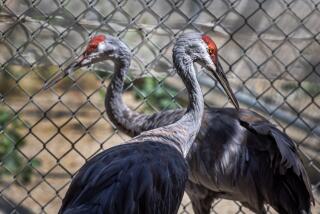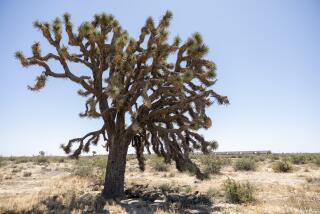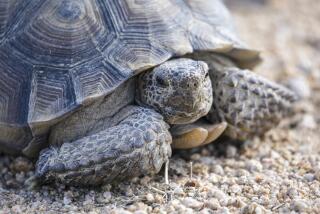Bighorns Hold Out in Desert
Mark Jorgensen stops dead in his tracks.
“Listen,” he says. “Did you hear that?”
I confess I didn’t.
“Wait, listen. “
We stand in the middle of Borrego Palm Canyon in Anza-Borrego Desert State Park in the middle of a July day. It is relatively cool, about 100 degrees.
We stand in the middle of Borrego Palm Canyon in the Anza-Borrego Desert State Park in the middle of a July day. It is relatively cool, about 100 degrees.
Sweat breaks out under my wide-brimmed hat, but the dry desert breeze evaporates it before I have much of a chance to feel it.
We are engaged in a hunt of sorts. That’s what brought us out into the desert at a time of year when Anza-Borrego is virtually, well, deserted.
“There it is again,” Jorgensen says.
It is the low bleating of a Peninsular Desert Bighorn Sheep, a borrego in Spanish, San Diego County’s official animal, one of the county’s rarest and maybe its most remarkable.
Jorgensen knows as much as anyone about the Peninsular bighorn. He began searching for them as a teen-ager. At the age of 20, he went to work for the state parks. Now, at 40, he is one of the bighorn’s greatest champions, defending the elusive horned sheep from stray cattle, water deprivation, disease and bureaucracy.
This year, the animals have been the focus of new attention by humans and their bureaucracies. The sheep were proposed in the May 8 edition of the Federal Register for listing as endangered under the Endangered Species Act of 1973. The proposal, filed by the U.S. Fish and Wildlife Service, was based on a petition from the Sierra Club.
According to Connie Babb of the U.S. Fish and Wildlife Service office in Carlsbad, the proposal is followed by a public comment period. In this case, the comment period will end Nov. 4. A final decision should be made by next May, a year from the time the sheep were first proposed for the list.
Based strictly on the numbers, the sheep might be considered a shoo-in for listing. The bighorn have decreased dramatically over the last two decades.
The herd is currently about 30% of what it was just 15 years ago. In 1979, Jorgensen said, there were about 1,170 Peninsular bighorn. Now there are about 380 left in the United States, mostly in Anza-Borrego.
In North America, populations for all bighorn varieties are also in a precipitous decline, according to biologist Jim DeForge, executive director of the nonprofit Bighorn Institute in Palm Desert. The overall population has fallen from an estimated 1 to 2 million in 1800 to about 40,000 now.
A census of the Peninsular bighorn in Anza-Borrego taken over the July 4 weekend counted 149 animals. But the census brought some good news, too. The ratio of lambs to ewes was 38 to 100, the third best in 22 years. The numbers mean that the sheep, at least this year, were more than replacing themselves.
Some agencies would like to avoid listing the Peninsular bighorn as an endangered species because of the sometimes complicated legal ramifications. Bighorn advocates such as DeForge agree that a listing and the accompanying bureaucratic regulations “will make our life a little more difficult,” they favor the listing as being in the best interests of the sheep.
For one thing, it will protect the sheep against loss of habitat. In its northern range outside the park boundaries near the Palm Springs area, hotel and resort development has been encroaching on sheep habitat. Listing the sheep as endangered will make such development more difficult.
Meanwhile, the Bureau of Land Management, the state’s Department of Fish and Game and the U.S. Fish and Wildlife Service are trying to develop a recovery plan.
If the bighorns fail to thrive, they will be at the end of a very long road.
Jorgensen said scientists believe the sheep now in Anza-Borrego are the descendants of sheep from the Near Eastern regions of Persia, Afghanistan and Kazakhstan. During the Pleistocene period, paleobiologists speculate, the sheep migrated across the land bridge between Siberia and Alaska.
The offspring of these sheep now inhabit a wide range from Alaska, through the Canadian Rockies, to the tip of Baja.
There are three subspecies in California: the Peninsular bighorn; its close relative, Nelson’s bighorn, and the California bighorn.
Scientists say the Peninsular bighorn moved into habitat that was relatively free of competitors and flourished.
The sheep have learned to eat the sparse desert grasses, agave, cactus fruit and other green vegetation. When they drink water, something they can avoid doing for three or four days at a time, they store almost all of it. They are capable of losing up to 30% of their total body weight, nearly all of it water, before needing another drink.
The bighorn are not huge animals--rams weigh about 180 to 220 pounds; ewes weigh about 120 pounds; lambs weigh 6 to 8 pounds at birth. The rams grow to about 3 feet in height (from hoof to shoulder) and the ewes are slightly shorter. The animals’ life span is 8 to 12 years.
The hoofs of the bighorn have been specially adapted to climb on the rocky hillsides found in the desert. Their bodies are insulated from the heat so well that they will often lie down in the middle of a summer day on flat rocks whose temperatures could cook meat.
Perhaps most amazing of all, the bighorn sheep begin to feel romantic in August, when temperatures regularly reach 110 degrees.
From early August through October, ewes enter what is euphemistically called “season.” Then males think of little else but sex.
“Males hang out in the winter and spring together in what is called ram bands,” explained Jorgensen. “But, when mating comes, the males engage in head-to-head combat to establish dominance. For rams, it’s like they are junior high school boys, where brute strength is more important than intellect, and they begin fighting over females.”
Jorgensen wasn’t kidding about head-to-head combat. That is the picture most people have of bighorn. The males will stand several yards apart, charge and slam their large curved horns into each other. The hills sometimes resound with crashing horns.
One August, several years ago, Jorgensen received a call about gunshots in the camping area of Borrego Palm Canyon. When he investigated, he found no guns, but rather warring male bighorns inside the shade ramadas of the campground.
Once a ram mates with a ewe and she conceives, a lamb will be born about 180 days later. Chances are it will die. In fact, about 80% of all lambs die within six months of birth. In 1991, the lamb mortality for a study area in the northern San Jacinto Mountains was 100%.
The lambs die of disease and predators. Coyotes will often scatter groups of bighorn looking for a lamb that falls back from the group because it is weak or diseased. Mountain lions, increasingly active in Anza-Borrego, have been taking more sheep since the drought began five years ago.
But the main worry for biologists now is not animal predators, but development and stray cattle.
Jorgensen believes the drought and well water drawn for irrigation have lowered the water table and dried up small water sources in bighorn habitat. That means the habitat can support fewer animals.
Stray, or feral, cattle have proven to be deadly. Jorgensen thinks they have spread viral infections and taken over watering holes formerly used by the sheep.
According to DeForge, viral infections make the sheep especially susceptible to pneumonia. Today, many bighorn die coughing and wheezing with the effects of pneumonia.
Jorgensen, who has a host of other duties in the park, would have his hands full just with the bighorn. He is the last state park naturalist in California to survive budget cuts. He has captured bighorn by jumping from helicopters, roped stray cattle, and built water stations in the middle of the desert. But the most common thing Jorgensen does for the bighorn is much simpler: he listens.
About 30 seconds have passed since Jorgensen heard the first bleat and then the second. I still haven’t heard a thing. Suddenly, faintly, I hear a plaintive “baaa” coming from somwhere in the hills.
“That’s a bighorn,” Jorgensen says. Then, like a scout out of an old Western, he says: “It’s about half a mile away over there.”
He points to a series of ridges near a giant wash and lifts his binoculars to his eyes, scanning the hillsides.
He offers me lunch if I can find the animal first.
I go hungry.
“There it is,” Jorgensen says.
He tries vainly to direct my binoculars and me to the bighorn. It is just above the V-shaped ocotillo. It is by the red rocks. Look at 10 o’clock, he advises.
Finally, the animal moves and I spot it. In fact, I had been looking at it all along, but its white hide melded perfectly with the rocks.
We retreated to the shade of a cliff side and sat watching the animal. Another one appeared, one Jorgensen identified as a yearling ram. The other one was a mature ewe.
He could distinguish the two by their sizes and their horns. A yearling ram will have horns that are just beginning to curve downward into the trademark curl of bighorn. By the age of 10 or 11, the horns will have made a full circle.
The ewe’s horns are much narrower and remain short no matter how old she gets.
“She’s probably lost a lamb, or she’s got a sick lamb nearby,” Jorgensen says to explain why the ewe is continuing to bleat. Ewes will sometimes stay for days in an area where a lamb has died, calling and hoping vainly to hear an answer.
The ewe wanders up and down the hillside, joined briefly by the young ram.
“You see that? She’s looking right at us,” Jorgensen says quietly.
“You mean looking in our direction?” I ask.
“No I mean looking right at us,” he says. “They can see us easily from where they are.”
Bighorn have binocular vision about eight times more powerful than the human eye. Their sight is among the most powerful of any mammal, and they can see a person walking in the desert from well beyond a mile away. There’s no sneaking up on a bighorn.
Soon, the ewe turns her attention from us and resumes walking in a small area, her hoofs clutching the hillside.
“Find the big cholla,” Jorgensen instructs urgently.
I do. There, next to a 6-foot-tall cholla, a ram stands on a rock, his body silhouetted against the blue sky. He surveys the desert canyons below and looks directly into my binoculars. As I stare back, I begin to understand what has inspired Jorgensen to spend the last 20 years in the desert.
More to Read
Sign up for Essential California
The most important California stories and recommendations in your inbox every morning.
You may occasionally receive promotional content from the Los Angeles Times.










